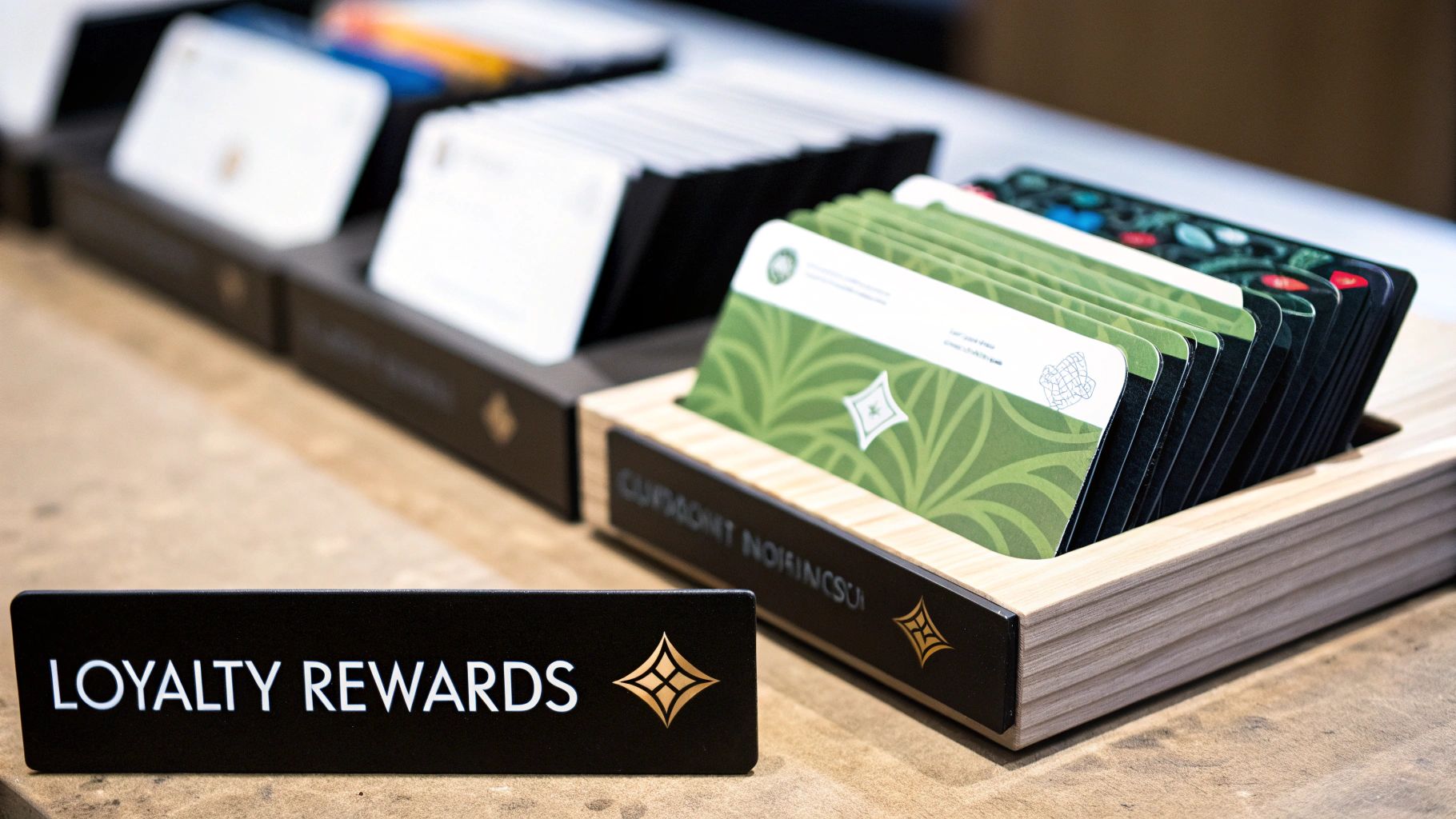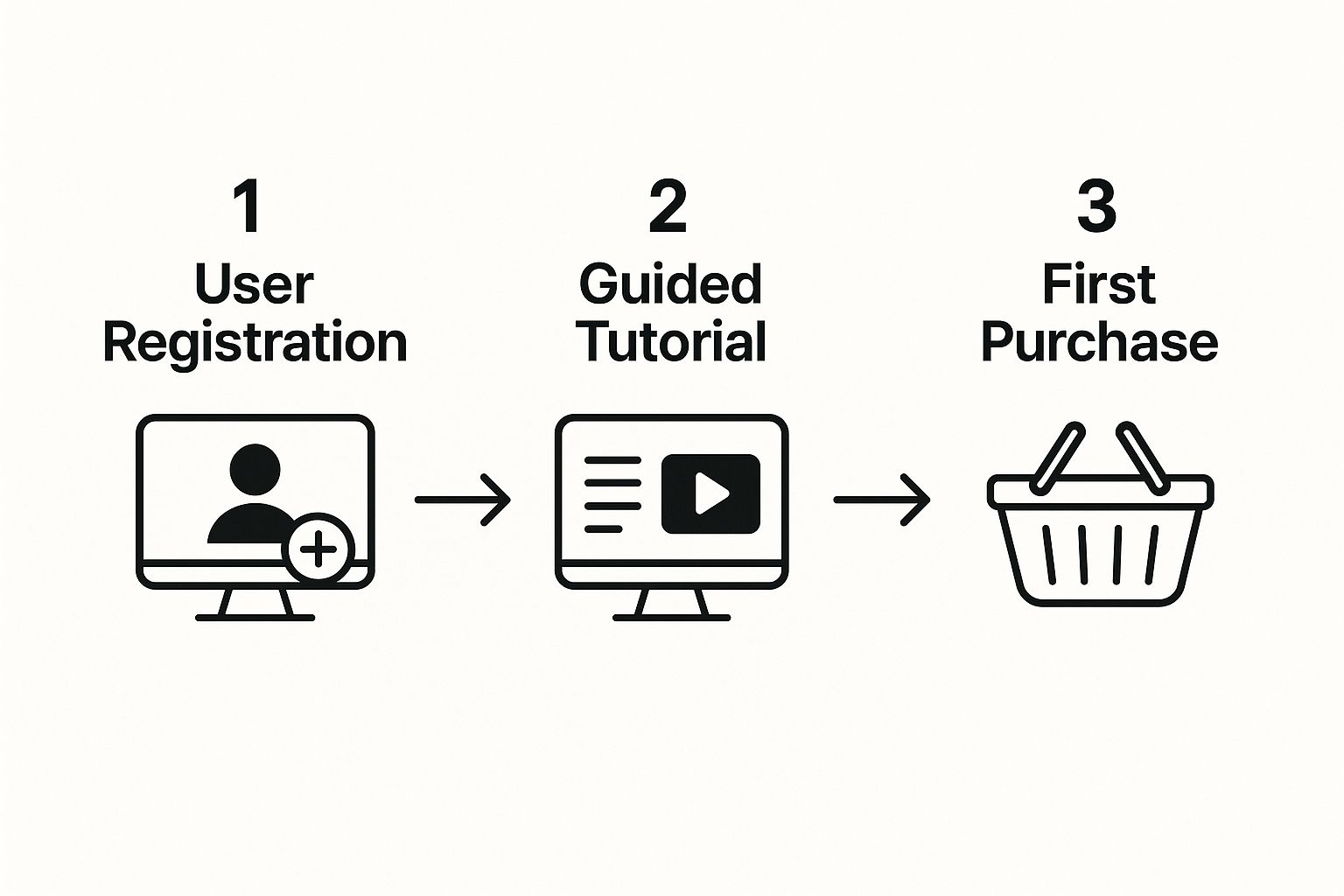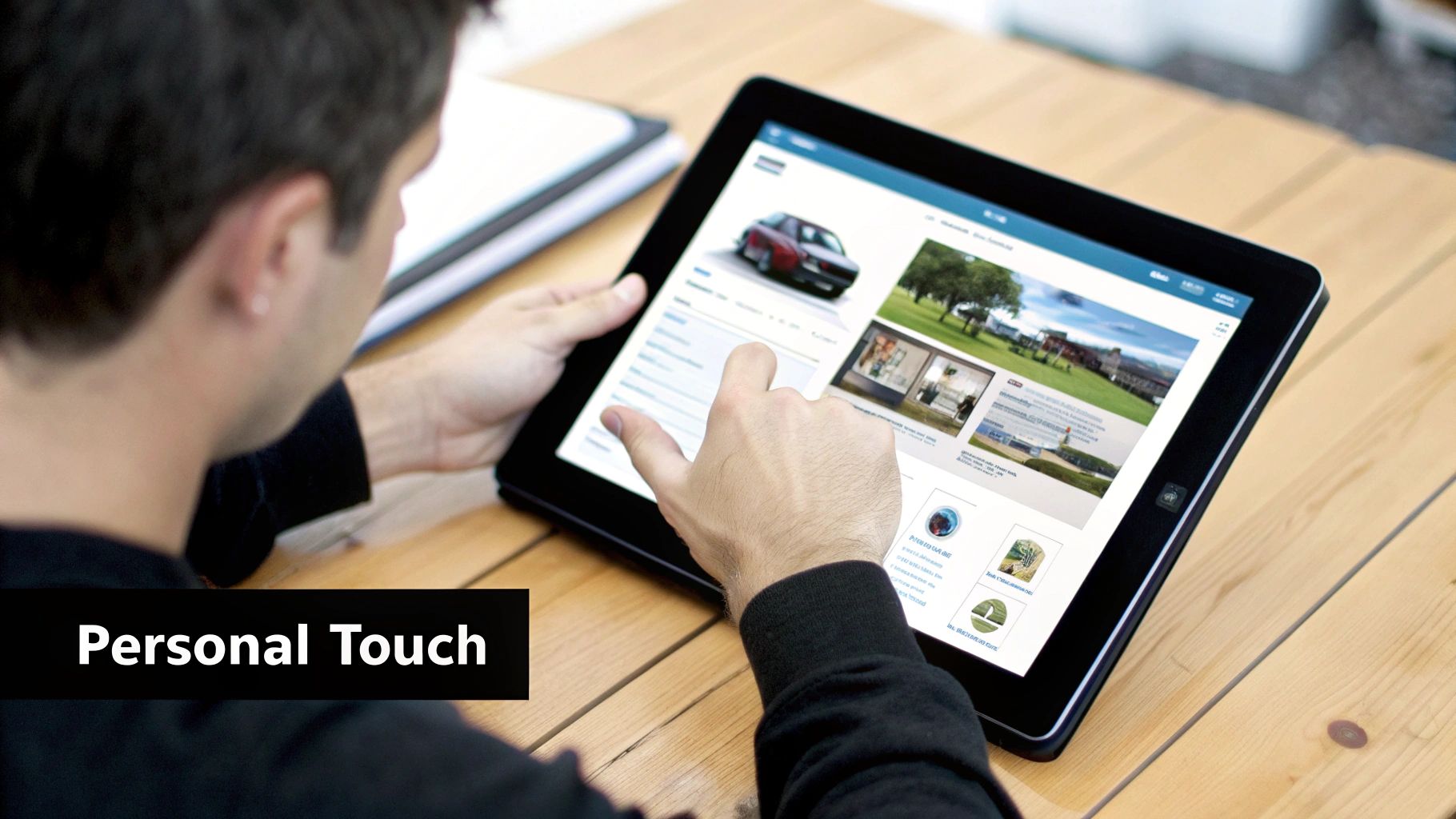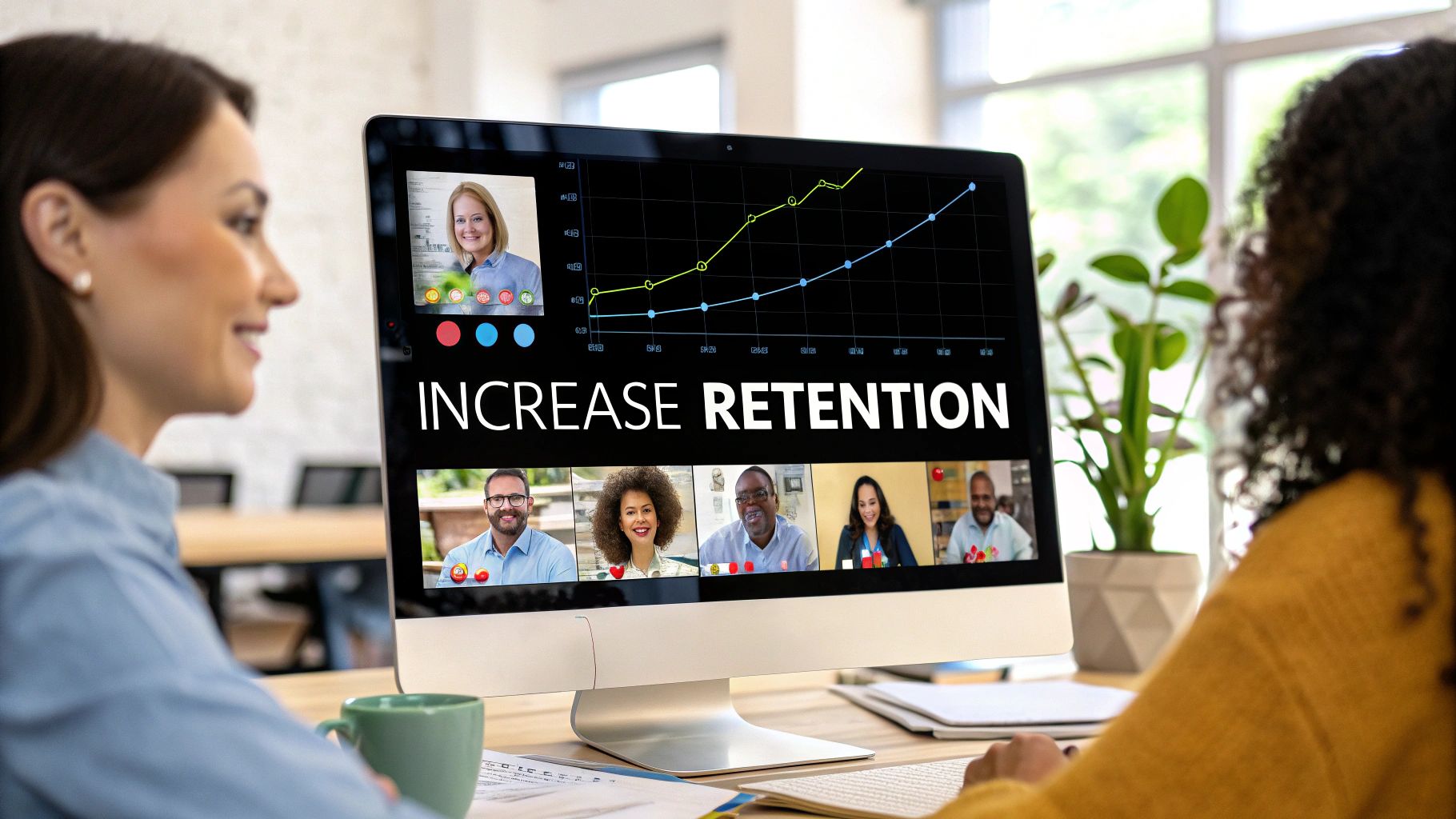In the relentless race for growth, it's easy for SaaS companies to get tunnel vision, focusing almost exclusively on landing new users. But here's a secret from the trenches: the real engine for sustainable success isn't just acquisition. It's your ability to increase customer retention. Keeping the customers you already have is hands-down more cost-effective and profitable than constantly chasing new ones.
Why SaaS Customer Retention Is Your Growth Engine

Let’s be real for a moment. The hunt for new customers is expensive and, frankly, exhausting. Sooner or later, every SaaS leader comes to the same conclusion: their existing customers are their most valuable asset. The conversation has moved beyond simply saying "retention is important" and into the stark financial realities of today's market.
The cost of churn is no longer a footnote; it's a critical boardroom issue. The numbers don't lie. Research from Bain & Company shows that increasing customer retention rates by just 5% can boost profits by a staggering 25% to 95%.
Now, compare that to the soaring costs of customer acquisition, which have shot up by nearly 60% over the past five years. Many businesses are now losing an average of $29 for each new customer they bring on board. This isn't just about plugging a leak; it's about building a solid foundation for scalable growth. Retained customers are the bedrock of predictable recurring revenue—the lifeblood of any subscription business.
The Financial Power of Loyalty
Happy, long-term customers do more than just stick around. They spend more. Over time, their average order value tends to climb as they adopt more features, upgrade their plans, and weave your tool deeper into their daily workflows. That kind of organic expansion is far more efficient than any top-of-funnel marketing campaign you could run.
A loyal customer base transforms your business from a leaky bucket, constantly needing to be refilled, into a powerful flywheel where retention fuels expansion and advocacy.
Putting a serious focus on retention directly impacts your profitability and long-term viability. It creates a more stable, predictable business model that’s resilient to market swings and competitive heat. Shifting from an acquisition-at-all-costs mindset isn't a defensive move; it’s the single most powerful strategy for sustainable growth.
Beyond the SaaS Model
While this guide zeroes in on the SaaS world, the core principles of engagement and loyalty are universal. These fundamentals apply across the board, whether you're in e-commerce, education, or enterprise services. In fact, understanding the broader concept of retention can give you a wider perspective on how different organizations build long-term relationships.
At the end of the day, every interaction a customer has with your product, your team, and your brand shapes their decision to stay or go. Every touchpoint is a chance to prove they made the right choice and build a relationship that's more than just a transaction.
Crafting an Unforgettable Onboarding Experience

Let's be honest: a customer's first interaction with your software can make or break the entire relationship. A clunky, confusing, or overwhelming onboarding process is a fast track to churn. On the flip side, a brilliant first impression is a cornerstone to increase customer retention. This is about more than a simple product tour; it’s about carefully designing a journey that makes your customer feel successful from the moment they log in.
Think of it this way: you could just hand someone a map and a compass, or you could be their personal guide, leading them directly to that stunning, hidden viewpoint. Your job is to be that guide, clearing a direct path to your product's core value—its "Aha!" moment.
Pave the Way to That "Aha!" Moment
The "Aha!" moment is that fantastic instant when a user truly gets the value your product offers. For a project management tool, it might be when they assign their first task and see it pop up on a teammate's board. For an analytics platform, it’s seeing a critical business insight jump out from their first imported dataset. Your number one onboarding mission? Get them to that point as fast as humanly possible.
To do this, you first need to know exactly what that moment is for your ideal customer. Once you’ve pinpointed it, work backward and ruthlessly eliminate every single point of friction along the way.
Here are a few ways to do that:
- Segmented Welcome Flows: A one-size-fits-all welcome email is a missed opportunity. Use signup data to tailor the experience. A user who signed up to “collaborate with my team” needs a very different onboarding track than someone looking to “manage personal projects.”
- Interactive In-App Guides: Ditch the passive tooltips. Instead, build interactive walkthroughs that guide users to take specific, valuable actions. Celebrate the small wins! A simple "Nice work!" message after they complete a key step builds momentum and makes them feel capable.
This approach flips onboarding from a tedious chore into a rewarding discovery, showing users the product's value instead of just telling them about it. That early hit of confidence is crucial for long-term stickiness.
Make It Personal and Proactive
Generic onboarding feels lazy because it is. To build a real foundation for loyalty, you have to show customers you’re invested in their specific success. That means layering in a human touch where it matters most.
The best onboarding doesn't just activate a user; it validates their decision to choose you. It reassures them that they've found a partner committed to helping them win.
A fantastic example is having a customer success manager send a quick, personalized video message to a new high-value account. It’s a simple gesture that can have a huge impact, forging a real connection from day one. Another great tactic is offering an optional 15-minute check-in call a week after signup. This can help you spot potential roadblocks before they become reasons for cancellation.
To make sure nothing slips through the cracks, a structured plan is your best friend. For a truly comprehensive approach, we recommend using an ultimate client onboarding checklist to guarantee every critical step is covered.
Onboarding Is Never a One-and-Done Deal
One of the biggest mistakes I see companies make is treating onboarding as a checkbox item that’s finished after the first week. True onboarding is an ongoing process of education and value delivery. As your product evolves and your customer’s needs change, you have to keep guiding them to new "Aha!" moments.
Think about these ongoing strategies:
- Feature Announcement Tours: When you launch something new, don't just bury it in an email. Create short, targeted in-app tours for specific user segments, showing them exactly how the feature works and why it’s a game-changer for them.
- Usage-Triggered Nudges: Keep an eye on user behavior. If a team hasn't touched a key collaboration feature after 30 days, why not trigger an automated email or an in-app prompt offering a quick tutorial? It shows you're paying attention and want them to get the most value.
By treating onboarding as a continuous journey, you consistently reinforce why your product is essential. This is how you turn initial curiosity into deep, lasting loyalty and seriously increase customer retention.
Shifting from Reactive Support to Proactive Success
If you're only helping customers after they've hit a roadblock and fired off a frustrated support ticket, you're playing a defensive game—and it's one you'll eventually lose. The real key to increasing customer retention is to flip that script entirely. It's time to move from a reactive, "firefighting" model to a proactive one where you’re solving problems before your customers even know they have them.
This isn't just a minor tweak; it's a fundamental change in how you view your relationship with customers, shifting it from purely transactional to truly strategic.
Instead of waiting for alarm bells, you start listening for the quiet signals that a customer might be struggling or slowly disengaging. This isn't about guesswork. It's about using the wealth of data you're already collecting. By tracking things like product usage, which features they've adopted, and even how often they log in, you can build a surprisingly clear picture of customer health.
This proactive mindset needs to be baked in right from the very beginning of the customer journey. You can see how each step is an opportunity to gather insights and gently guide users toward success.

The visual above really drives home how every touchpoint—from the moment they sign up to their first meaningful action—is a chance to build momentum and head off churn before it can take root.
Identifying At-Risk Customers with Data
Your product analytics are a goldmine for spotting churn before it happens. The trick is to define what an "at-risk" customer actually looks like for your business. It's rarely about just one thing, like inactivity, but more about subtle shifts in their behavior.
Keep an eye out for warning signs like these:
- Declining Usage: A team that was logging in daily is now only popping in once a week.
- Key Feature Neglect: They've completely ignored a core feature that's central to getting real value from your product.
- Support Ticket Spikes: A sudden flood of support requests from one account often signals deep-seated frustration.
- Ignoring New Features: You've rolled out valuable updates, but a specific group of users hasn't touched any of them.
These behaviors are the digital equivalent of a customer quietly packing their bags. Setting up alerts for these triggers allows your customer success team to jump in before it’s too late.
Proactive success isn't about having a crystal ball. It's about systematically interpreting user behavior as a direct reflection of the value they're getting—or aren't getting—from your product.
This approach demands a different mindset. You're no longer just a support agent closing tickets; you're a strategic advisor, actively working to ensure your customers hit their goals using your tool.
From Insight to Actionable Intervention
Spotting a problem is only half the battle. What you do next is what truly matters, and a generic "Hey, how's it going?" email just won't cut it. Your outreach has to be specific and show you've been paying attention to their unique situation.
For example, if you see a team is struggling to adopt your reporting features, don't just send a link to a generic help doc. A much better move is a personalized email offering a quick, 15-minute screen-share to walk their team lead through a custom report setup that directly helps their business. It shows you're not just another vendor—you're a partner invested in their success.
To really understand the difference, let's look at how the two models stack up against each other.
Proactive vs Reactive Customer Support Models
The table below breaks down the fundamental differences between a forward-thinking customer success strategy and a traditional, reactive support model. It highlights the shift in goals, timing, and ultimately, the business outcomes you can expect from each approach.
| Attribute | Proactive Customer Success | Reactive Customer Support |
|---|---|---|
| Goal | Ensure customer achieves their desired outcomes. | Resolve an immediate, reported issue. |
| Timing | Before issues arise, based on data triggers. | After a customer reports a problem. |
| Focus | Long-term value and relationship building. | Short-term problem-solving and ticket closure. |
| Outcome | Increased loyalty, upsell opportunities, and advocacy. | Customer satisfaction with the specific resolution. |
As you can see, the proactive model is designed for long-term health and growth, not just immediate problem-solving.
This proactive engine naturally uncovers opportunities to increase customer retention and even drive expansion. When you schedule a business review to highlight an underused feature, you’re not just preventing churn; you're demonstrating deeper value that could easily lead to an upsell. By transforming your support function into a success-driven machine, you turn potential churners into your most loyal and valuable advocates.
5. Turn Customer Feedback into Your Next Killer Feature

Want to know a secret? Your most brilliant product roadmap is already written. It’s sitting right there in your support tickets, user reviews, and in-app chat logs. Your customers hold the keys to your product's future—but only if you know how to listen and, more importantly, how to act.
This goes way beyond sending out a generic Net Promoter Score (NPS) survey once a year. To really get a pulse on what your users need, you need to create intentional channels for them to share their thoughts. The goal is to turn those raw insights into your most beloved features, which is a fantastic way to increase customer retention.
Go Beyond Basic Surveys
Annual surveys have their place, but they often lack the immediacy and context to drive real change. To get to the heart of what your users want, you have to meet them where they are: right inside your product.
Consider implementing more dynamic feedback methods:
- Targeted In-App Forms: Instead of a generic "how are we doing?" popup, trigger specific questions after a user completes a key action. For instance, after someone exports a report for the first time, you could ask, "Did this report have all the data you needed? What's one thing that would make it more useful?" This gives you hyper-relevant feedback you can act on immediately.
- Customer Advisory Boards (CABs): For your most engaged and valuable customers, a CAB can be a goldmine. This small, dedicated group of users provides high-level strategic feedback, helping you validate your roadmap and stay aligned with your core audience's evolving needs.
These methods show you’re not just collecting data; you're starting a conversation. It builds a sense of partnership that makes customers feel genuinely valued.
The Magic of Closing the Feedback Loop
Collecting feedback is just the start. The real magic—the part that builds unshakable loyalty—is "closing the loop." This means actively telling customers how their specific insights led to tangible product improvements. It’s the ultimate validation of their time and effort.
Don’t just build what customers ask for. Build what they ask for, then tell them you built it because they asked for it. This simple act transforms a user into a co-creator and a loyal advocate.
Imagine a user suggests a small UI tweak to save them a few clicks. Six weeks later, they get a personal email from your product manager: "Hi Sarah, remember that idea you had for the dashboard? We just shipped it. Thanks for helping us make the product better!" That's an experience a competitor can't easily replicate.
A fascinating industry study shows just how critical this is. It reveals that media and professional services boast the highest global retention rates at an impressive 84%, largely because their business models are built on actively understanding and responding to client needs. When customers feel heard, they stick around. You can explore more data and see how different industries compare.
From Complaint to Prized Feature
Some of the best features start out as complaints. When a user says, "I hate that I have to do X, Y, and Z to get this done," what they're really handing you is a blueprint for a streamlined workflow.
Here’s a real-world scenario. A SaaS company with a social media scheduling tool noticed a pattern in support tickets: users were frustrated with manually resizing images for each platform. It was a recurring point of friction.
Instead of just updating their help docs, the product team listened. They built an "auto-magic resizer" that automatically adapted a single uploaded image for Instagram, Twitter, and Facebook with one click. They then launched the feature with a blog post titled, "You Spoke, We Listened: Say Goodbye to Manual Image Resizing."
The result was a triple win:
- Resolved a Major Pain Point: Support ticket volume on this topic dropped significantly.
- Created a "Wow" Moment: The feature became a key selling point highlighted in demos.
- Strengthened Customer Relationships: The users who originally complained felt directly responsible for a major product improvement, cementing their loyalty.
By systematically collecting, analyzing, and—most crucially—acting on customer feedback, you create a powerful cycle. You improve your product, make your customers feel like valued partners, and build a competitive moat based on a superior user experience. This deep sense of ownership is what truly helps increase customer retention for the long haul.
Forget Points—Here’s How You Build Real Loyalty
Let's be honest: the old-school, transaction-based loyalty program is dead. A generic "earn 1 point for every dollar spent" system feels tired because it is. Customers see right through it. If you want to improve client retention with strategic programs, you have to think bigger than just rewarding purchases.
Real loyalty isn't about transactions; it's about connection. It's about making your best customers feel like they're on the inside track. The goal is to create a genuine sense of community and exclusivity. So, instead of another 10% off coupon, ask yourself what your power users truly want. Is it a sneak peek at your product roadmap? Maybe it's direct access to content that helps them master your tool. This is how you build a program that people actually care about.
Moving Beyond Simple Discounts
A strong loyalty strategy digs into what really motivates your users long after they've swiped their credit card. While discounts are a nice-to-have, they rarely forge a deep, lasting bond. The best programs today reward people for their engagement and their time with you, not just their wallet.
Here are a few ideas that actually work:
- Early Access to New Features: Your most loyal users are often your biggest advocates. Give them a first look at beta features. This not only makes them feel valued but also gives you priceless feedback from a super-qualified group before a public launch.
- Exclusive Content for Power Users: Think about creating a private library of advanced tutorials, expert-led webinars, or in-depth strategy guides that only long-term customers can access. It's a fantastic way to reward their commitment while helping them get even more value from your platform.
- Tiers That Enhance the Experience: A tiered system (think Bronze, Silver, Gold) can be incredibly powerful if the perks are meaningful. Forget slightly bigger discounts. Instead, offer tangible benefits like priority support, a dedicated success manager, or higher usage limits as customers climb the ladder.
These approaches shift the conversation from "spend more, save more" to "the longer you're with us, the better your experience gets." It’s a powerful change in perspective.
The Referral Engine: Turning Loyalty into Growth
Your happiest customers are, without a doubt, your most effective and affordable sales team. A smart referral program doesn't just bring in new business; it strengthens the loyalty of the person doing the referring. It creates this wonderful flywheel where retention fuels acquisition, which in turn drives sustainable growth.
The secret to a great referral program is the dual-sided incentive. Everyone wins. The new customer gets a warm welcome with a bonus, and your existing customer gets a thank-you for spreading the word. It's a powerful validation of their decision to choose you.
Take a project management tool, for example. It could offer a new user 20% off their first three months and give the referrer a $50 account credit. Both parties get immediate, tangible value. The real key here is to make it absolutely frictionless. The referral link needs to be easy to find, a cinch to share, and simple to track—ideally, all from within the customer’s dashboard. Embedding the program right into your app is a game-changer for participation.
Designing a Program That Truly Connects
The most successful loyalty and referral programs are never one-size-fits-all. They feel like a natural extension of the product and are built with a deep understanding of the user base. Before you roll anything out, you need to be able to answer a few critical questions:
- What specific behavior are we trying to encourage? Is it just more purchases, or is it something deeper, like leaving reviews, participating in a community forum, or referring new customers?
- What do our customers actually find valuable? Don't guess—ask them! Run a survey with your top users. You might be shocked to learn they’d prefer early feature access or priority support over a small discount.
- How can we make this feel special? Ditch the corporate jargon. Use language that builds a sense of community, like "Join our Insider's Club" or "Become a Brand Ambassador."
By digging into these questions, you can move past generic templates and build a program that genuinely connects with your audience, turning happy users into your most passionate advocates.
The Real Financial Cost of Losing a Customer
https://www.youtube.com/embed/pqQikNTKASs
We’ve talked about the strategies for building loyalty and engaging your customers, but let's ground all of that in reality by looking at the hard numbers. The tangible financial damage from customer churn is what makes the mission to increase customer retention a top-tier, company-wide priority. It’s not just a fuzzy metric; it's a direct hit to your bottom line.
Every single interaction a customer has with your brand—from their first onboarding session to a random support ticket—shapes their experience and ultimately their decision to stick around or walk away. The stakes are incredibly high, because the cost of attrition is so much more than just a lost subscription payment.
The Staggering Price of Attrition
When you zoom out and look at the bigger picture, the numbers are jaw-dropping. U.S. brands are estimated to lose a mind-boggling $168 billion every year simply because customers leave. This isn't a problem that only affects a specific type of company; it's a universal pain point.
Some industries, like hospitality and travel, get hit especially hard, with retention rates as low as 55%. But make no mistake, almost every business feels the financial sting of high churn. You can see more data on how customer experience impacts retention across industries on thepetrovaexperience.com.
Prioritizing your existing customers isn't just about providing good service—it's the most direct and reliable path to profitability and building a resilient future for your business.
This financial reality is precisely why the retention strategies in this guide are so critical. Each tactic, whether it's proactive support or a well-designed loyalty program, is a shield against these massive potential losses. For a deeper dive into practical steps, check out our guide on how to reduce churn rate and protect your revenue.
A Company-Wide Mission
One of the biggest mistakes I see companies make is thinking retention is solely the job of the customer support team. That’s a recipe for failure. In reality, it’s a collective responsibility that involves everyone.
- Product teams are on the hook for building features that deliver real, ongoing value.
- Marketing teams must set the right expectations from the very first ad a customer sees.
- Success teams are the guides who ensure users actually achieve their goals with your tool.
Ultimately, every employee has a hand in creating an experience that customers simply don't want to leave. When you adopt this unified mindset, retention stops being a defensive reaction and becomes a core growth strategy that secures your most valuable asset: your existing customers.
Answering Your Top SaaS Customer Retention Questions
When you're trying to nail down customer retention, it's natural for questions to pop up. Getting straight answers is the key to building a strategy that actually works. Let's tackle some of the most common questions we hear from fellow SaaS leaders.
How Do I Calculate My Customer Retention Rate?
Figuring out your Customer Retention Rate (CRR) is a lot less intimidating than it sounds, and it gives you a crucial pulse on the health of your business. All you need to do is pick a specific period to measure—say, a month or a quarter.
Once you have your timeframe, grab these three key numbers:
- The number of customers at the start of the period (S).
- The number of customers at the end of the period (E).
- The number of new customers you signed up during that period (N).
Then, just plug them into this simple formula: [(E - N) / S] x 100 = CRR%.
This final percentage tells you exactly how good you are at keeping the customers you already have.
I'm on a Tight Budget. What Are My First Moves?
You absolutely don't need a massive budget to increase customer retention. The trick is to focus on high-impact actions that don't cost a fortune.
Your first step? Just listen. Dive into your support tickets and live chats. Look for common complaints or points of friction that keep tripping people up, and then get to work fixing them.
Next, make a point to close the feedback loop. When a customer suggests a feature and you actually build it, send them a quick, personal email to share the good news. It costs you nothing but time and builds an incredible amount of goodwill. For even more budget-friendly ideas, check out our full guide on SaaS customer retention strategies.
How Often Should I Be Asking for Customer Feedback?
Think of feedback as an ongoing conversation, not a one-time event. Ditch the idea of a single, massive annual survey. Instead, aim for smaller, more frequent check-ins that feel natural.
The best way to do this is by asking for feedback right in the moment. Use targeted, in-app prompts after a user successfully completes a key task or hits a new milestone. This approach gives you timely, relevant insights you can use right away.
What’s the Real Difference Between Retention and Loyalty?
It’s a great question, and the distinction is critical. Retention is a behavior, while loyalty is an emotion.
Retention simply means a customer keeps paying you. They might stick around because it's convenient, or because switching to a competitor feels like too much of a hassle. It’s a transactional relationship.
Loyalty, on the other hand, runs much deeper. A loyal customer stays because they genuinely value your product and the relationship you've built. They’re the ones who will champion your brand and tell their friends about you. The ultimate goal isn't just to retain customers, but to transform them into true, loyal advocates.
Ready to turn your most loyal customers into your best growth channel? With Refgrow, you can launch a fully native affiliate program inside your SaaS in minutes. Start building your referral engine and watch your growth multiply. Get started with Refgrow today.

